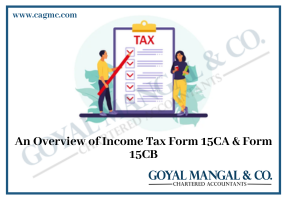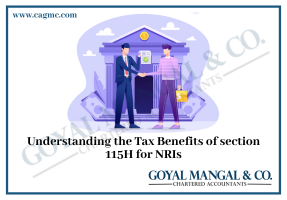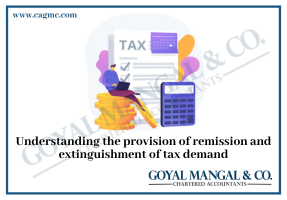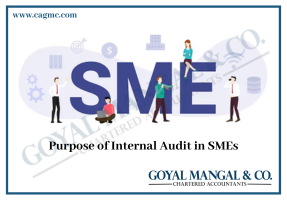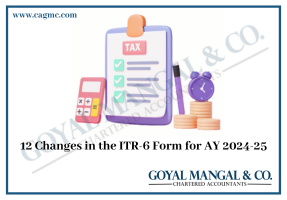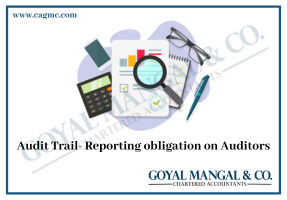 People may invest in capital assets to provide a source of funding for their future financial goals, assure long-term financial stability, and be self-sufficient in the event of economic adversity. However, the profits they make from selling these capital assets are known as capital gains. According to the Income Tax Act,1961, a gain of this nature is taxable. Nevertheless, some elements of the Income-tax law permit taxpayers to make particular claims of exemptions against such gains, which helps them lower their tax bills. Do you want to reduce your capital gains tax now? Utilizing the provisions of two significant portions of the Act, sections 54 and 54F, will allow you to reduce the tax you pay on your capital appreciation.
People may invest in capital assets to provide a source of funding for their future financial goals, assure long-term financial stability, and be self-sufficient in the event of economic adversity. However, the profits they make from selling these capital assets are known as capital gains. According to the Income Tax Act,1961, a gain of this nature is taxable. Nevertheless, some elements of the Income-tax law permit taxpayers to make particular claims of exemptions against such gains, which helps them lower their tax bills. Do you want to reduce your capital gains tax now? Utilizing the provisions of two significant portions of the Act, sections 54 and 54F, will allow you to reduce the tax you pay on your capital appreciation.
What is the advantage of long-term capital assets?
The main advantage of having an asset classified as a long-term capital asset is that the assessee is qualified to get the indexation benefit. Additionally, some deductions are only applicable to long-term capital investments.
What are the exemptions under section 54?
According to Section 54 of the Income-tax Act, a person or HUF may be eligible for tax deductions on long-term capital gains resulting from the sale of a residential property if the money is used to buy or build another residential property.
The following are the main requirements that must be met to take advantage of this section:
- Only an individual or HUF is eligible for the exemption under Section 54. This clause prohibits taxpayers like partnership firms, LLPs, corporations, AOPs, or Bois from requesting relief.
- The transferable asset, which is a residential property, should be a long-term capital asset.
- If there is any income from the transferred residential property, it should be reported under the heading “Income from House Property.”
- The seller shall purchase or construct one residential house within one year before, two years following, or three years following the date of the transfer.
- The location of the new residential property should be India. The taxpayer is not permitted to use this section’s exemption to buy or build a residence abroad.
The aforementioned conditions build upon one another. Therefore, the assessee will not be able to claim the benefit of the exemption under Section 54 even if anyone criteria are not met.
Section 54 has been changed with effect from AY 2021–22 to prolong the exemption for investments made in two residential housing properties in India. Only if long-term capital gains do not exceed Rs. 2 crores will the investment made to buy or build two residential housing properties be eligible for the exemption. It should be emphasized that once the taxpayer uses this option, he will not be able to use it again for that assessment year or any future.
How much exemption is permitted under Section 54 of the Income Tax Act?
According to Section 54 of the Income Tax Act, long-term capital gains are exempt up to the lesser of the following amounts:
- Long time Gains in capital from the sale of a residential property,
- investments in the building of new homes for residential usage. Therefore, any remaining capital gains case will be subject to tax.
Provisions relating to the transfer of the Residential property under Section 54
To prevent the provisions of section 54 from being exploited, the government has added a requirement to make sure that the new house property purchased to claim the exemption under this section is held for a specific amount of time. The limitation forbids selling the new home property within three years of the date of purchase or construction, whichever comes first.
When calculating the capital gain arising from the transfer of a new house, the amount of the capital gains exemption obtained under section 54 will be deducted from the cost of acquisition or building of the new house if the exemption is claimed under section 54 and the new house is sold within three years of its purchase or construction. As a result, the cost of purchasing or building a new home will drop or even disappear, depending on the situation, leading to more significant capital gains when the home is sold.
What are the exceptions of Section 54F?
By Section 54F of the Income-tax Act, an individual or HUF may receive tax exemptions on capital gains on the transfer of long-term capital assets other than residential properties provided the proceeds of such investments are used to buy or build residential properties in India.
The following are the fundamental requirements that must be met to make use of section 54F:
- An individual or HUF is the sole entity that is eligible for the exemption under this section.
- If you transfer any long-term capital asset other than a residential residence, you are eligible for the exemption from capital gains taxes.
- The taxpayer should put their investment of the original asset’s net consideration in one of the following:
- To acquire one residential property in India within a time frame of one year before or two years following the date of transfer of the original asset.
- To build one residential property in India within three years of the date of transfer.
According to this provision, “net consideration” for the transfer of a capital asset refers to the whole amount of the consideration received or accruing in connection with the transfer of the capital asset less any expenses that were incurred solely for that transfer.
Amount of exception under Section 54F
- The entire capital gain shall be exempt under section 54F if the cost of purchasing or constructing the new asset exceeds the net consideration received or accrued about the transfer of the previous asset.
- If the cost of the new asset is less than the net consideration relative to the original asset, or if the entire sale consideration is not invested in the new asset, then exemption shall be permitted proportionately as follows:
Amount of exemption = Long-term capital gain * (Amount invested in the new asset/Net sale consideration)
Situations where Exemption under Section 54F is not Given
- The taxpayer purchases any residential house, other than the new asset, within a year of the date of transfer of the original asset, and the income from such residential home is chargeable under the head “Income from house property.”
- The taxpayer has more than one residential house, other than the new asset, on the date of transfer of the original asset.
- Within three years of the original asset’s transfer date, the taxpayer builds any residential house other than the new asset, the income from which is taxable under the “Income from House Property” heading.
If the taxpayer constructs a residential house within three years of the date of the transfer of the original asset or buys one within two years of that date, the amount of the capital gain on the transfer of the original asset that was exempt under Section 54F shall be charged as long-term capital gains in the fiscal year in which the residential house is purchased, whichever comes first.
Provisions relating to the transfer of the Residential property under Section 54F
Similar to section 54, u/s 54F also applies a three-year lock-in term on the transfer of a new residential house starting from the date of purchase or building, as applicable.
The amount of capital gain resulting from the transfer of the authentic asset exempted in the year of such transfer shall be treated as long-term capital gains of the fiscal year in which such new asset is transferred if the exemption is claimed under section 54F and the new house is transferred within three years of the date of its purchase/construction.
Judgments
If the assessee possesses multiple residential apartments or residential units located in the same building on the date of the asset transfer, only one residential house property will be considered for section 54F purposes. The following court rulings have been used to establish this viewpoint:
- SHRI. NAVIN JOLLY C/O NAVIN ARCHITECT PRIVATE LIMITED VERSUS THE INCOME-TAX OFFICER, WARD 11 (1) [2020] 424 ITR 462 (Kar)
According to the ruling, “The assessee even otherwise is entitled to the benefit of exemption under Section 54F (1) of the Act as the assessee owns two 500 square foot apartments in the same building and hence it has to be classified as one residential unit.”
- SRI S.M. VINOD, L/R OF LATE SM MUNIYAPPA VERSUS THE INCOME TAX OFFICER, WARD 7 (2) (1), BANGALORE
According to the ruling, “The assessee owns one independent building with two units, one on the first floor and the other on the ground floor. The presence of two units does not alter the building’s status as “one residential house,” as in the case of Shri Ramaiah Harish [2021 (9) TMI 1138 – ITAT BANGALORE]. So, we tell the AO to comply with Section 54F of the Act and grant the deduction. The assessee’s arguments are accepted.
How does the Capital Gains Account scheme work?
The assessee is required to deposit the number of gains in the Capital Gains Account Scheme in any branch of a public sector bank before the deadline for filing income tax returns if the asset is sold in the PY and the seller intends to but has not yet purchased the new home property due to the 2 or 3-year time limit still being in effect.
When claiming the deduction, the amount already spent on the purchase or construction as well as the sum placed in the capital gains account plan may be claimed as costs.
What are the similarities between Sections 54 and 54F?
- A new residential house property must be bought or built to qualify for the exemption. Meanwhile, it must be done either one year before or two years after the transfer of the original asset.
- However, the new residential property needs to be built within three years of when the original asset was transferred.
- Similar lock-in periods of three years are stated in both sections for the transfer of new assets from the date of acquisition or construction of the original assets, as applicable.
- Both provisions provide for the possibility of putting unused capital gain funds into the Capital Gains Account Scheme.
What are the differences between Section 54 and 54F?
- The asset on which the exemption is offered under each section is where the key distinction rests. When a residential house property is transferred, the long-term capital gain is eligible for the exemption under Section 54. As opposed to this, under section 54F, the exemption applies to long-term capital gains on the transfer of any asset other than a residential home.
- The entire capital gain must be invested in the new asset to qualify for full exemption under Section 54. In contrast, to be fully exempt under Section 54F, the entire net consideration must be invested in the new asset.
- If the amount of capital gains does not exceed Rs. 2 crores, there is a once-in-a-lifetime opportunity to claim exemption on capital gains under section 54 on investing such gain in two properties. Under Section 54F, there is no such option for investing in two assets.
- To be eligible for the exemption under Section 54F, the taxpayer must not have owned more than one residential property on the date the original asset was transferred, aside from the new asset. Section 54 makes no mention of this prohibition.
Takeaway
A taxpayer (individual or HUF) can save a significant amount of taxes if the sale and acquisition of capital assets are planned with the provisions of sections 54 and 54F in mind. To profit from the relief offered under the aforementioned sections, taxpayers must thoroughly grasp these rules and organize their investments accordingly.

